Analyzing Work Diversity in the Workplace: A Cross-Cultural Interaction Study
VerifiedAdded on 2023/01/12
|10
|2140
|39
AI Summary
This assignment analyzes and evaluates the elements of work diversity in the workplace, specifically focusing on cross-cultural interaction. The research methodology, findings, and discussion provide insights into the lessons learned from this study.
Contribute Materials
Your contribution can guide someone’s learning journey. Share your
documents today.
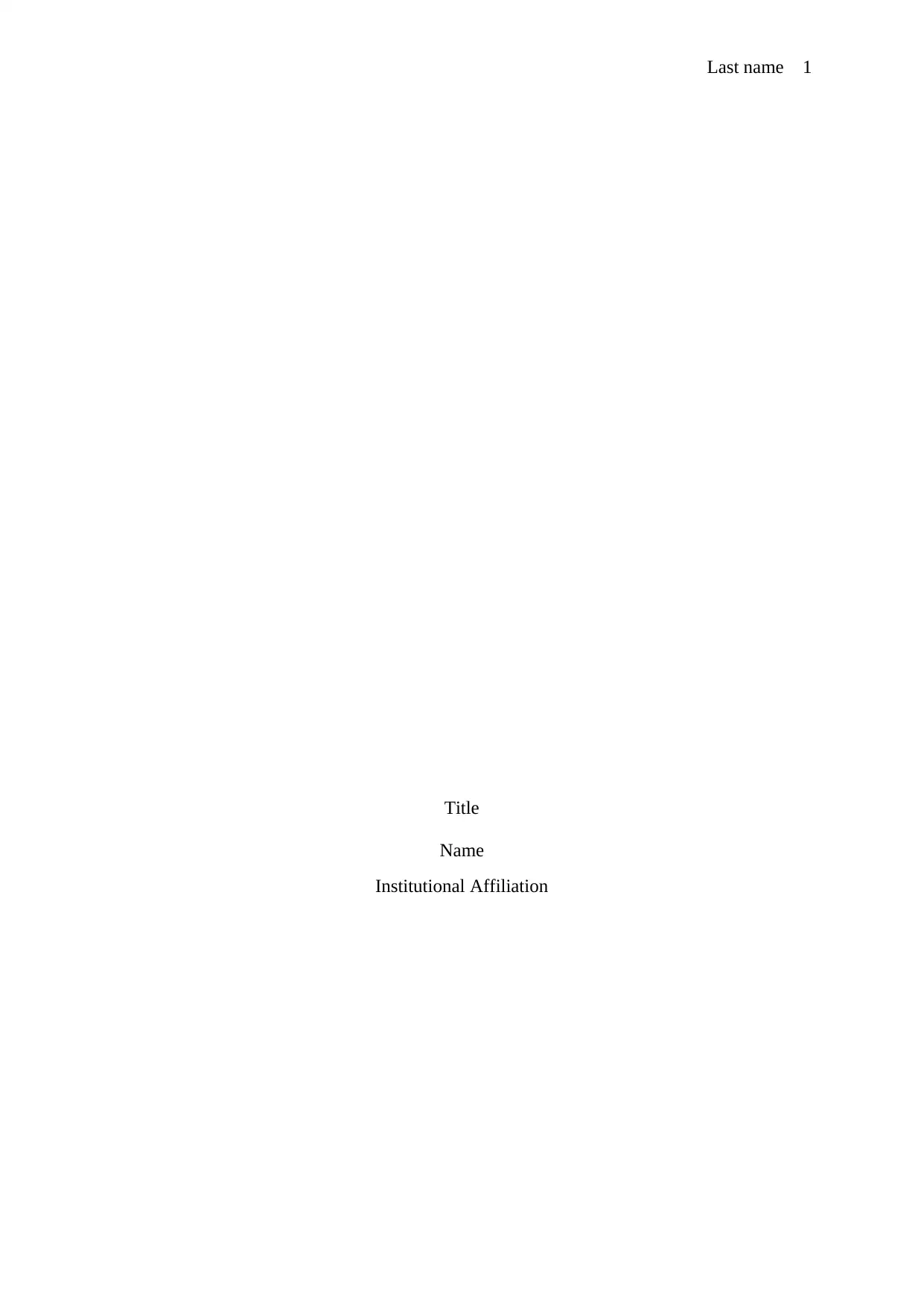
Last name 1
Title
Name
Institutional Affiliation
Title
Name
Institutional Affiliation
Secure Best Marks with AI Grader
Need help grading? Try our AI Grader for instant feedback on your assignments.
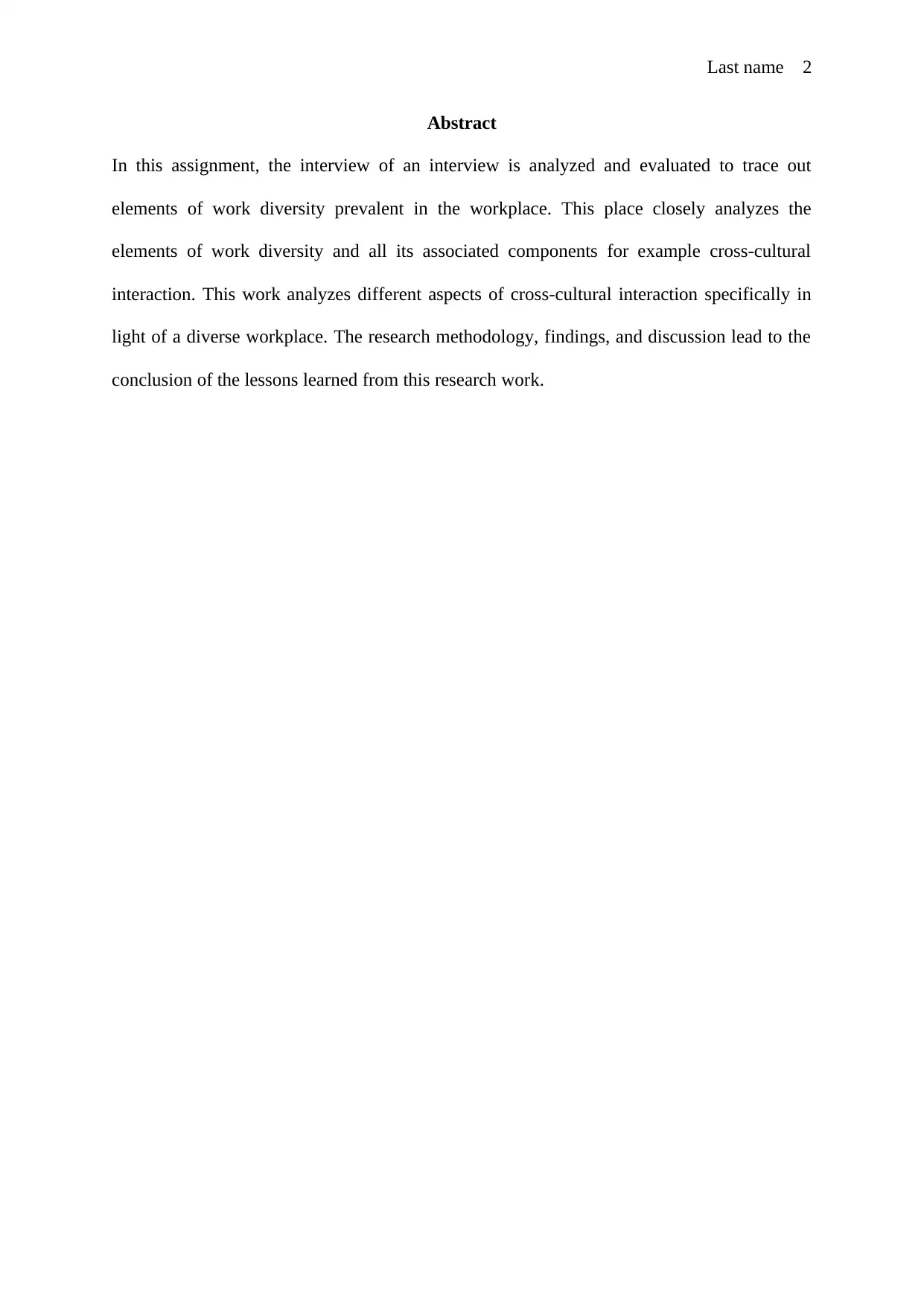
Last name 2
Abstract
In this assignment, the interview of an interview is analyzed and evaluated to trace out
elements of work diversity prevalent in the workplace. This place closely analyzes the
elements of work diversity and all its associated components for example cross-cultural
interaction. This work analyzes different aspects of cross-cultural interaction specifically in
light of a diverse workplace. The research methodology, findings, and discussion lead to the
conclusion of the lessons learned from this research work.
Abstract
In this assignment, the interview of an interview is analyzed and evaluated to trace out
elements of work diversity prevalent in the workplace. This place closely analyzes the
elements of work diversity and all its associated components for example cross-cultural
interaction. This work analyzes different aspects of cross-cultural interaction specifically in
light of a diverse workplace. The research methodology, findings, and discussion lead to the
conclusion of the lessons learned from this research work.
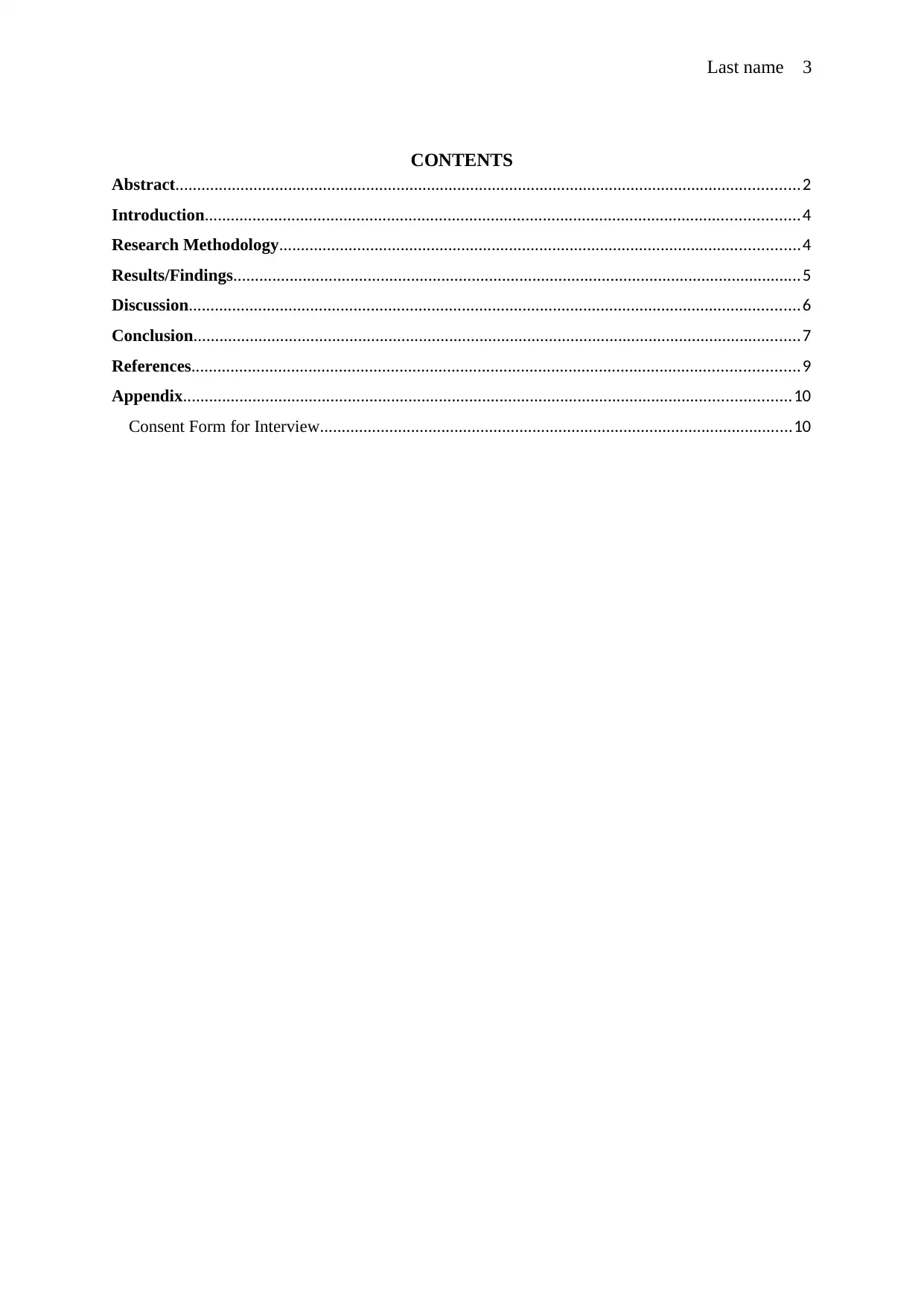
Last name 3
CONTENTS
Abstract................................................................................................................................................2
Introduction.........................................................................................................................................4
Research Methodology........................................................................................................................4
Results/Findings...................................................................................................................................5
Discussion.............................................................................................................................................6
Conclusion............................................................................................................................................7
References............................................................................................................................................9
Appendix............................................................................................................................................10
Consent Form for Interview.............................................................................................................10
CONTENTS
Abstract................................................................................................................................................2
Introduction.........................................................................................................................................4
Research Methodology........................................................................................................................4
Results/Findings...................................................................................................................................5
Discussion.............................................................................................................................................6
Conclusion............................................................................................................................................7
References............................................................................................................................................9
Appendix............................................................................................................................................10
Consent Form for Interview.............................................................................................................10
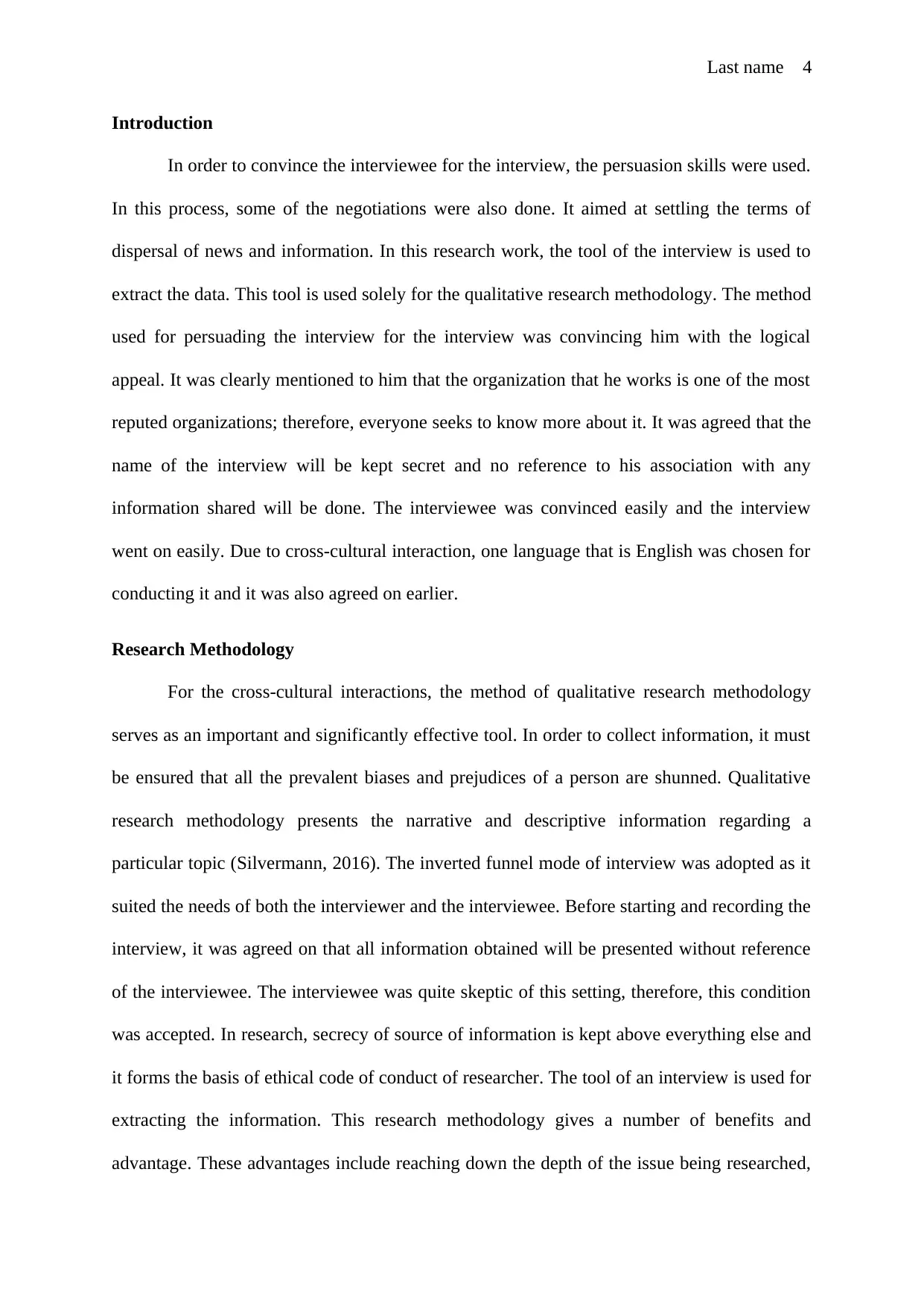
Last name 4
Introduction
In order to convince the interviewee for the interview, the persuasion skills were used.
In this process, some of the negotiations were also done. It aimed at settling the terms of
dispersal of news and information. In this research work, the tool of the interview is used to
extract the data. This tool is used solely for the qualitative research methodology. The method
used for persuading the interview for the interview was convincing him with the logical
appeal. It was clearly mentioned to him that the organization that he works is one of the most
reputed organizations; therefore, everyone seeks to know more about it. It was agreed that the
name of the interview will be kept secret and no reference to his association with any
information shared will be done. The interviewee was convinced easily and the interview
went on easily. Due to cross-cultural interaction, one language that is English was chosen for
conducting it and it was also agreed on earlier.
Research Methodology
For the cross-cultural interactions, the method of qualitative research methodology
serves as an important and significantly effective tool. In order to collect information, it must
be ensured that all the prevalent biases and prejudices of a person are shunned. Qualitative
research methodology presents the narrative and descriptive information regarding a
particular topic (Silvermann, 2016). The inverted funnel mode of interview was adopted as it
suited the needs of both the interviewer and the interviewee. Before starting and recording the
interview, it was agreed on that all information obtained will be presented without reference
of the interviewee. The interviewee was quite skeptic of this setting, therefore, this condition
was accepted. In research, secrecy of source of information is kept above everything else and
it forms the basis of ethical code of conduct of researcher. The tool of an interview is used for
extracting the information. This research methodology gives a number of benefits and
advantage. These advantages include reaching down the depth of the issue being researched,
Introduction
In order to convince the interviewee for the interview, the persuasion skills were used.
In this process, some of the negotiations were also done. It aimed at settling the terms of
dispersal of news and information. In this research work, the tool of the interview is used to
extract the data. This tool is used solely for the qualitative research methodology. The method
used for persuading the interview for the interview was convincing him with the logical
appeal. It was clearly mentioned to him that the organization that he works is one of the most
reputed organizations; therefore, everyone seeks to know more about it. It was agreed that the
name of the interview will be kept secret and no reference to his association with any
information shared will be done. The interviewee was convinced easily and the interview
went on easily. Due to cross-cultural interaction, one language that is English was chosen for
conducting it and it was also agreed on earlier.
Research Methodology
For the cross-cultural interactions, the method of qualitative research methodology
serves as an important and significantly effective tool. In order to collect information, it must
be ensured that all the prevalent biases and prejudices of a person are shunned. Qualitative
research methodology presents the narrative and descriptive information regarding a
particular topic (Silvermann, 2016). The inverted funnel mode of interview was adopted as it
suited the needs of both the interviewer and the interviewee. Before starting and recording the
interview, it was agreed on that all information obtained will be presented without reference
of the interviewee. The interviewee was quite skeptic of this setting, therefore, this condition
was accepted. In research, secrecy of source of information is kept above everything else and
it forms the basis of ethical code of conduct of researcher. The tool of an interview is used for
extracting the information. This research methodology gives a number of benefits and
advantage. These advantages include reaching down the depth of the issue being researched,
Secure Best Marks with AI Grader
Need help grading? Try our AI Grader for instant feedback on your assignments.
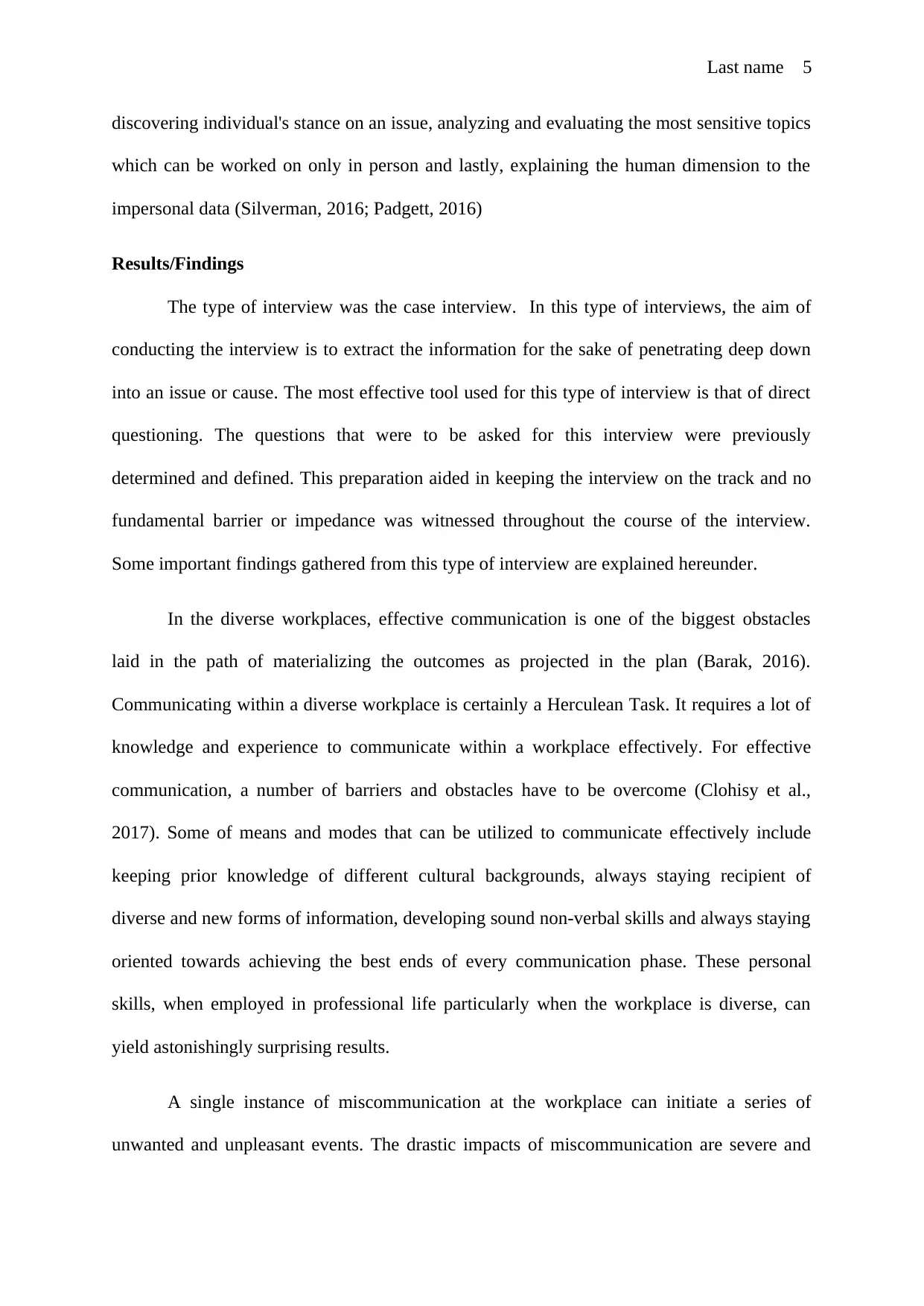
Last name 5
discovering individual's stance on an issue, analyzing and evaluating the most sensitive topics
which can be worked on only in person and lastly, explaining the human dimension to the
impersonal data (Silverman, 2016; Padgett, 2016)
Results/Findings
The type of interview was the case interview. In this type of interviews, the aim of
conducting the interview is to extract the information for the sake of penetrating deep down
into an issue or cause. The most effective tool used for this type of interview is that of direct
questioning. The questions that were to be asked for this interview were previously
determined and defined. This preparation aided in keeping the interview on the track and no
fundamental barrier or impedance was witnessed throughout the course of the interview.
Some important findings gathered from this type of interview are explained hereunder.
In the diverse workplaces, effective communication is one of the biggest obstacles
laid in the path of materializing the outcomes as projected in the plan (Barak, 2016).
Communicating within a diverse workplace is certainly a Herculean Task. It requires a lot of
knowledge and experience to communicate within a workplace effectively. For effective
communication, a number of barriers and obstacles have to be overcome (Clohisy et al.,
2017). Some of means and modes that can be utilized to communicate effectively include
keeping prior knowledge of different cultural backgrounds, always staying recipient of
diverse and new forms of information, developing sound non-verbal skills and always staying
oriented towards achieving the best ends of every communication phase. These personal
skills, when employed in professional life particularly when the workplace is diverse, can
yield astonishingly surprising results.
A single instance of miscommunication at the workplace can initiate a series of
unwanted and unpleasant events. The drastic impacts of miscommunication are severe and
discovering individual's stance on an issue, analyzing and evaluating the most sensitive topics
which can be worked on only in person and lastly, explaining the human dimension to the
impersonal data (Silverman, 2016; Padgett, 2016)
Results/Findings
The type of interview was the case interview. In this type of interviews, the aim of
conducting the interview is to extract the information for the sake of penetrating deep down
into an issue or cause. The most effective tool used for this type of interview is that of direct
questioning. The questions that were to be asked for this interview were previously
determined and defined. This preparation aided in keeping the interview on the track and no
fundamental barrier or impedance was witnessed throughout the course of the interview.
Some important findings gathered from this type of interview are explained hereunder.
In the diverse workplaces, effective communication is one of the biggest obstacles
laid in the path of materializing the outcomes as projected in the plan (Barak, 2016).
Communicating within a diverse workplace is certainly a Herculean Task. It requires a lot of
knowledge and experience to communicate within a workplace effectively. For effective
communication, a number of barriers and obstacles have to be overcome (Clohisy et al.,
2017). Some of means and modes that can be utilized to communicate effectively include
keeping prior knowledge of different cultural backgrounds, always staying recipient of
diverse and new forms of information, developing sound non-verbal skills and always staying
oriented towards achieving the best ends of every communication phase. These personal
skills, when employed in professional life particularly when the workplace is diverse, can
yield astonishingly surprising results.
A single instance of miscommunication at the workplace can initiate a series of
unwanted and unpleasant events. The drastic impacts of miscommunication are severe and
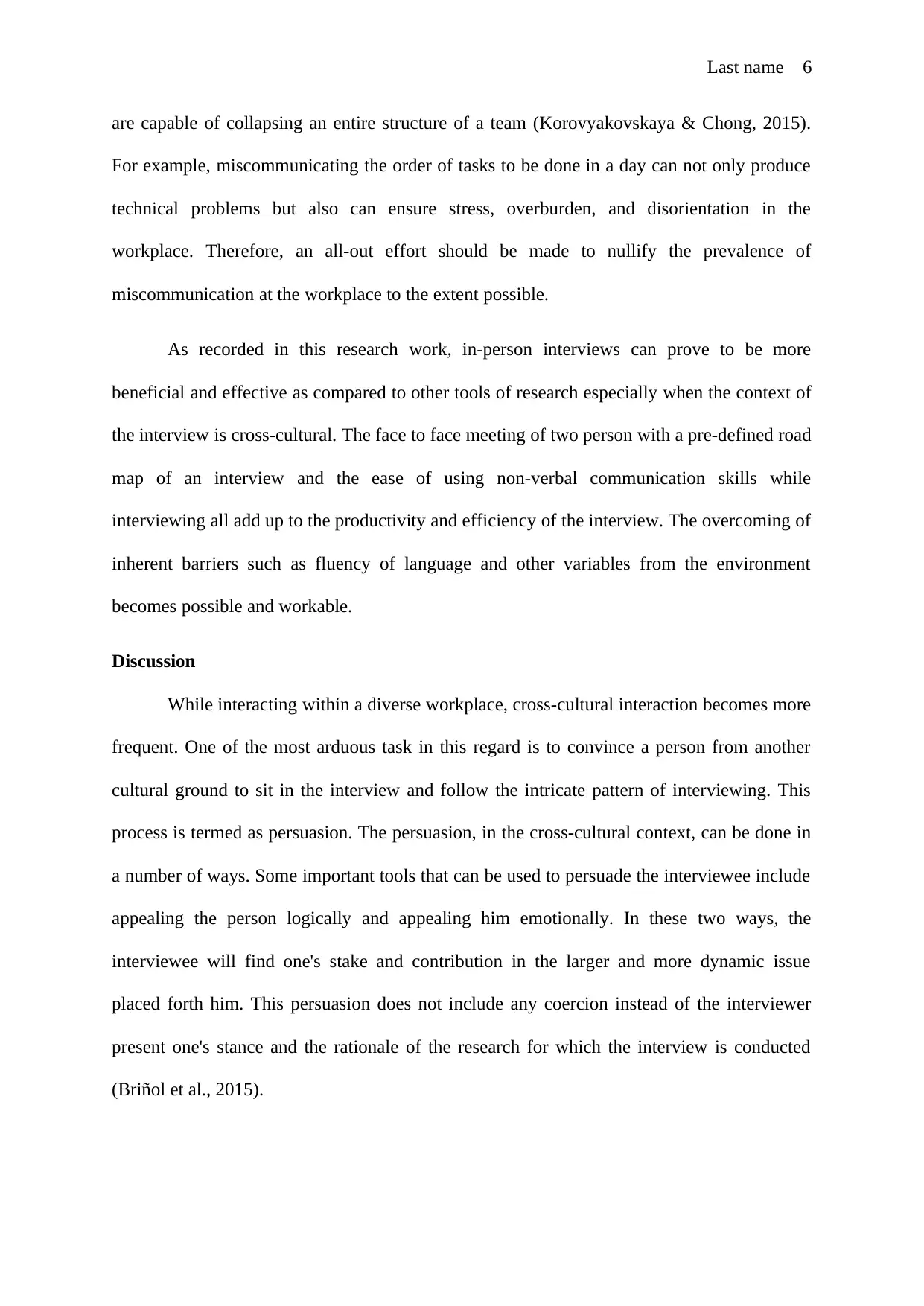
Last name 6
are capable of collapsing an entire structure of a team (Korovyakovskaya & Chong, 2015).
For example, miscommunicating the order of tasks to be done in a day can not only produce
technical problems but also can ensure stress, overburden, and disorientation in the
workplace. Therefore, an all-out effort should be made to nullify the prevalence of
miscommunication at the workplace to the extent possible.
As recorded in this research work, in-person interviews can prove to be more
beneficial and effective as compared to other tools of research especially when the context of
the interview is cross-cultural. The face to face meeting of two person with a pre-defined road
map of an interview and the ease of using non-verbal communication skills while
interviewing all add up to the productivity and efficiency of the interview. The overcoming of
inherent barriers such as fluency of language and other variables from the environment
becomes possible and workable.
Discussion
While interacting within a diverse workplace, cross-cultural interaction becomes more
frequent. One of the most arduous task in this regard is to convince a person from another
cultural ground to sit in the interview and follow the intricate pattern of interviewing. This
process is termed as persuasion. The persuasion, in the cross-cultural context, can be done in
a number of ways. Some important tools that can be used to persuade the interviewee include
appealing the person logically and appealing him emotionally. In these two ways, the
interviewee will find one's stake and contribution in the larger and more dynamic issue
placed forth him. This persuasion does not include any coercion instead of the interviewer
present one's stance and the rationale of the research for which the interview is conducted
(Briñol et al., 2015).
are capable of collapsing an entire structure of a team (Korovyakovskaya & Chong, 2015).
For example, miscommunicating the order of tasks to be done in a day can not only produce
technical problems but also can ensure stress, overburden, and disorientation in the
workplace. Therefore, an all-out effort should be made to nullify the prevalence of
miscommunication at the workplace to the extent possible.
As recorded in this research work, in-person interviews can prove to be more
beneficial and effective as compared to other tools of research especially when the context of
the interview is cross-cultural. The face to face meeting of two person with a pre-defined road
map of an interview and the ease of using non-verbal communication skills while
interviewing all add up to the productivity and efficiency of the interview. The overcoming of
inherent barriers such as fluency of language and other variables from the environment
becomes possible and workable.
Discussion
While interacting within a diverse workplace, cross-cultural interaction becomes more
frequent. One of the most arduous task in this regard is to convince a person from another
cultural ground to sit in the interview and follow the intricate pattern of interviewing. This
process is termed as persuasion. The persuasion, in the cross-cultural context, can be done in
a number of ways. Some important tools that can be used to persuade the interviewee include
appealing the person logically and appealing him emotionally. In these two ways, the
interviewee will find one's stake and contribution in the larger and more dynamic issue
placed forth him. This persuasion does not include any coercion instead of the interviewer
present one's stance and the rationale of the research for which the interview is conducted
(Briñol et al., 2015).
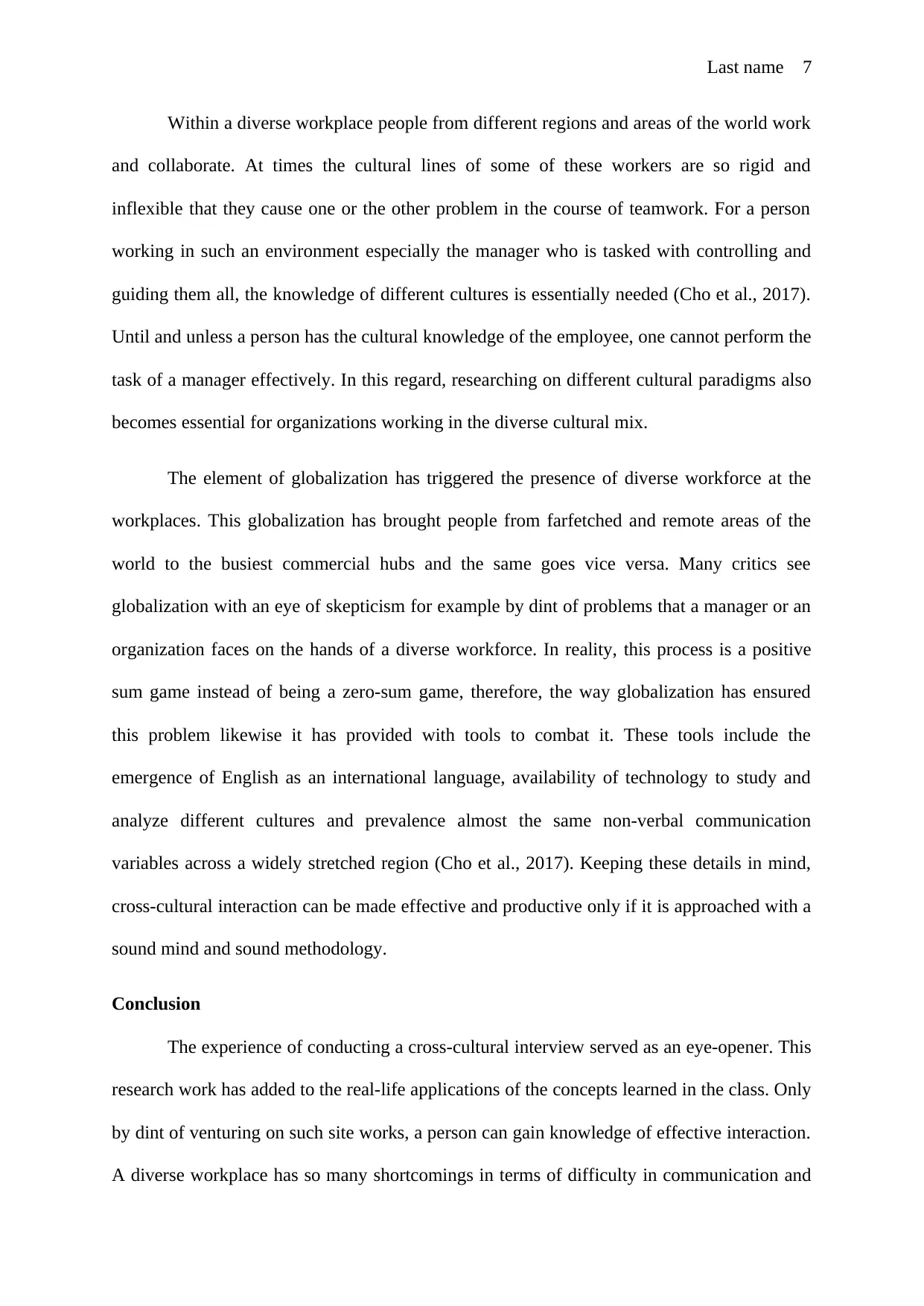
Last name 7
Within a diverse workplace people from different regions and areas of the world work
and collaborate. At times the cultural lines of some of these workers are so rigid and
inflexible that they cause one or the other problem in the course of teamwork. For a person
working in such an environment especially the manager who is tasked with controlling and
guiding them all, the knowledge of different cultures is essentially needed (Cho et al., 2017).
Until and unless a person has the cultural knowledge of the employee, one cannot perform the
task of a manager effectively. In this regard, researching on different cultural paradigms also
becomes essential for organizations working in the diverse cultural mix.
The element of globalization has triggered the presence of diverse workforce at the
workplaces. This globalization has brought people from farfetched and remote areas of the
world to the busiest commercial hubs and the same goes vice versa. Many critics see
globalization with an eye of skepticism for example by dint of problems that a manager or an
organization faces on the hands of a diverse workforce. In reality, this process is a positive
sum game instead of being a zero-sum game, therefore, the way globalization has ensured
this problem likewise it has provided with tools to combat it. These tools include the
emergence of English as an international language, availability of technology to study and
analyze different cultures and prevalence almost the same non-verbal communication
variables across a widely stretched region (Cho et al., 2017). Keeping these details in mind,
cross-cultural interaction can be made effective and productive only if it is approached with a
sound mind and sound methodology.
Conclusion
The experience of conducting a cross-cultural interview served as an eye-opener. This
research work has added to the real-life applications of the concepts learned in the class. Only
by dint of venturing on such site works, a person can gain knowledge of effective interaction.
A diverse workplace has so many shortcomings in terms of difficulty in communication and
Within a diverse workplace people from different regions and areas of the world work
and collaborate. At times the cultural lines of some of these workers are so rigid and
inflexible that they cause one or the other problem in the course of teamwork. For a person
working in such an environment especially the manager who is tasked with controlling and
guiding them all, the knowledge of different cultures is essentially needed (Cho et al., 2017).
Until and unless a person has the cultural knowledge of the employee, one cannot perform the
task of a manager effectively. In this regard, researching on different cultural paradigms also
becomes essential for organizations working in the diverse cultural mix.
The element of globalization has triggered the presence of diverse workforce at the
workplaces. This globalization has brought people from farfetched and remote areas of the
world to the busiest commercial hubs and the same goes vice versa. Many critics see
globalization with an eye of skepticism for example by dint of problems that a manager or an
organization faces on the hands of a diverse workforce. In reality, this process is a positive
sum game instead of being a zero-sum game, therefore, the way globalization has ensured
this problem likewise it has provided with tools to combat it. These tools include the
emergence of English as an international language, availability of technology to study and
analyze different cultures and prevalence almost the same non-verbal communication
variables across a widely stretched region (Cho et al., 2017). Keeping these details in mind,
cross-cultural interaction can be made effective and productive only if it is approached with a
sound mind and sound methodology.
Conclusion
The experience of conducting a cross-cultural interview served as an eye-opener. This
research work has added to the real-life applications of the concepts learned in the class. Only
by dint of venturing on such site works, a person can gain knowledge of effective interaction.
A diverse workplace has so many shortcomings in terms of difficulty in communication and
Paraphrase This Document
Need a fresh take? Get an instant paraphrase of this document with our AI Paraphraser
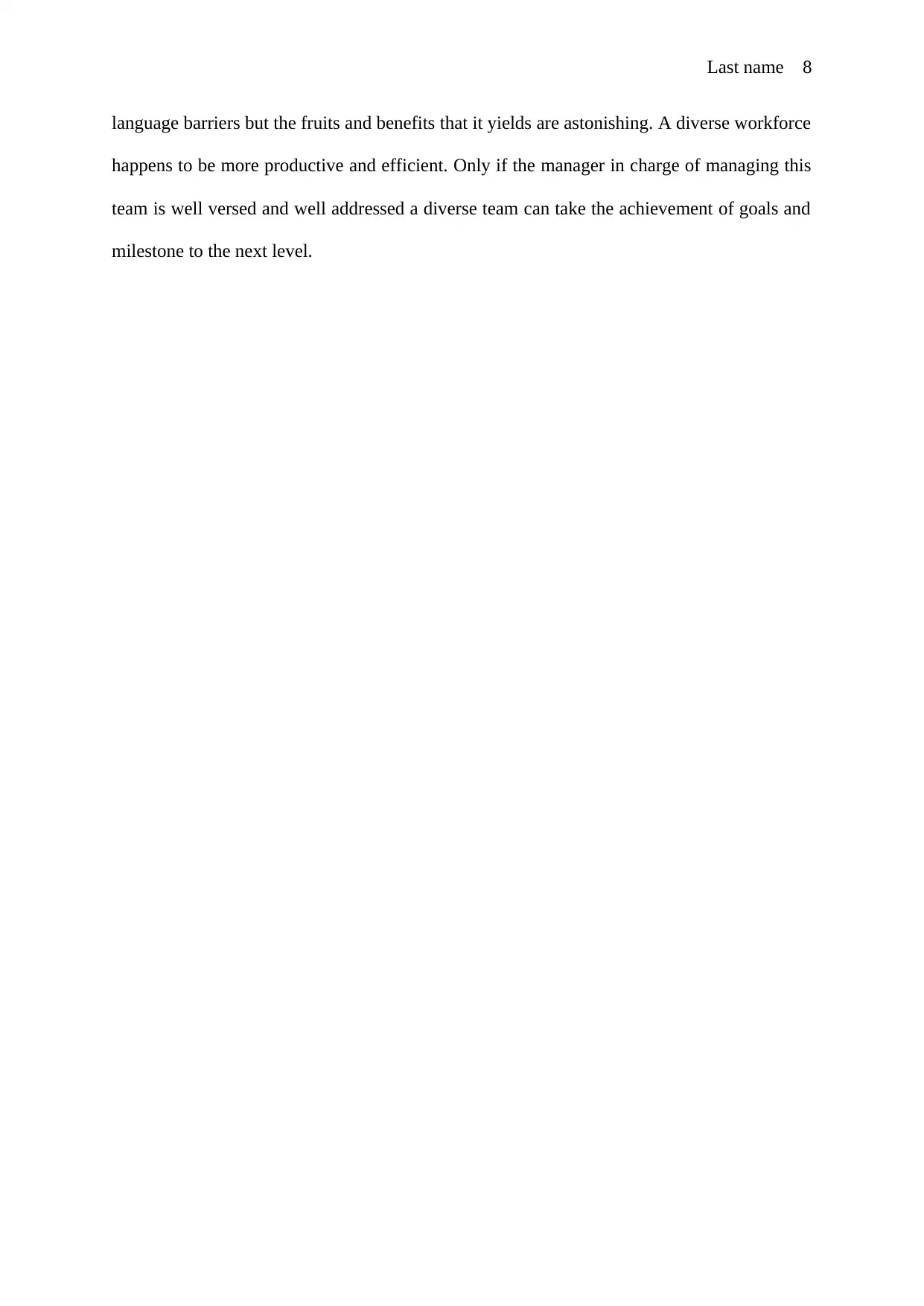
Last name 8
language barriers but the fruits and benefits that it yields are astonishing. A diverse workforce
happens to be more productive and efficient. Only if the manager in charge of managing this
team is well versed and well addressed a diverse team can take the achievement of goals and
milestone to the next level.
language barriers but the fruits and benefits that it yields are astonishing. A diverse workforce
happens to be more productive and efficient. Only if the manager in charge of managing this
team is well versed and well addressed a diverse team can take the achievement of goals and
milestone to the next level.
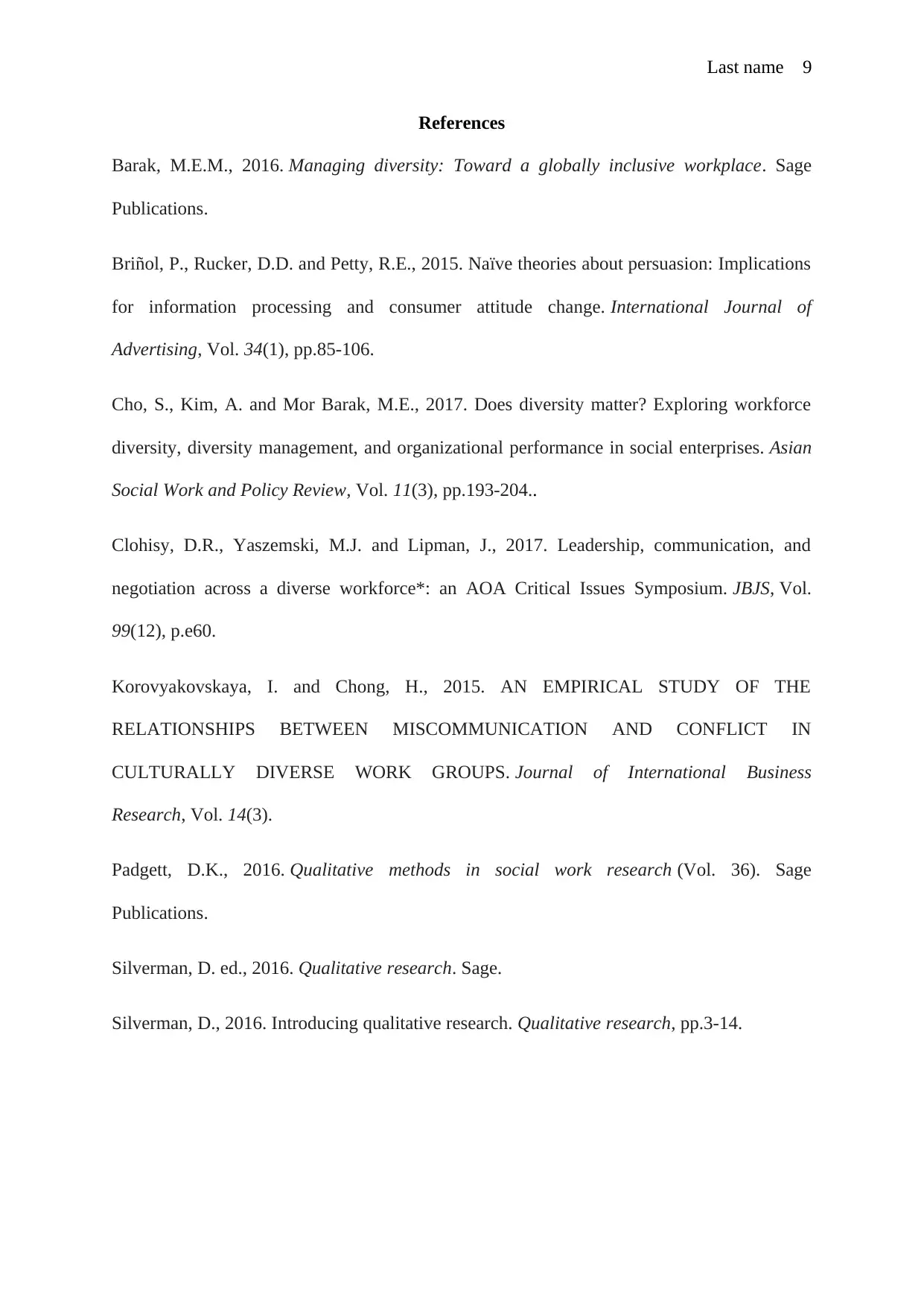
Last name 9
References
Barak, M.E.M., 2016. Managing diversity: Toward a globally inclusive workplace. Sage
Publications.
Briñol, P., Rucker, D.D. and Petty, R.E., 2015. Naïve theories about persuasion: Implications
for information processing and consumer attitude change. International Journal of
Advertising, Vol. 34(1), pp.85-106.
Cho, S., Kim, A. and Mor Barak, M.E., 2017. Does diversity matter? Exploring workforce
diversity, diversity management, and organizational performance in social enterprises. Asian
Social Work and Policy Review, Vol. 11(3), pp.193-204..
Clohisy, D.R., Yaszemski, M.J. and Lipman, J., 2017. Leadership, communication, and
negotiation across a diverse workforce*: an AOA Critical Issues Symposium. JBJS, Vol.
99(12), p.e60.
Korovyakovskaya, I. and Chong, H., 2015. AN EMPIRICAL STUDY OF THE
RELATIONSHIPS BETWEEN MISCOMMUNICATION AND CONFLICT IN
CULTURALLY DIVERSE WORK GROUPS. Journal of International Business
Research, Vol. 14(3).
Padgett, D.K., 2016. Qualitative methods in social work research (Vol. 36). Sage
Publications.
Silverman, D. ed., 2016. Qualitative research. Sage.
Silverman, D., 2016. Introducing qualitative research. Qualitative research, pp.3-14.
References
Barak, M.E.M., 2016. Managing diversity: Toward a globally inclusive workplace. Sage
Publications.
Briñol, P., Rucker, D.D. and Petty, R.E., 2015. Naïve theories about persuasion: Implications
for information processing and consumer attitude change. International Journal of
Advertising, Vol. 34(1), pp.85-106.
Cho, S., Kim, A. and Mor Barak, M.E., 2017. Does diversity matter? Exploring workforce
diversity, diversity management, and organizational performance in social enterprises. Asian
Social Work and Policy Review, Vol. 11(3), pp.193-204..
Clohisy, D.R., Yaszemski, M.J. and Lipman, J., 2017. Leadership, communication, and
negotiation across a diverse workforce*: an AOA Critical Issues Symposium. JBJS, Vol.
99(12), p.e60.
Korovyakovskaya, I. and Chong, H., 2015. AN EMPIRICAL STUDY OF THE
RELATIONSHIPS BETWEEN MISCOMMUNICATION AND CONFLICT IN
CULTURALLY DIVERSE WORK GROUPS. Journal of International Business
Research, Vol. 14(3).
Padgett, D.K., 2016. Qualitative methods in social work research (Vol. 36). Sage
Publications.
Silverman, D. ed., 2016. Qualitative research. Sage.
Silverman, D., 2016. Introducing qualitative research. Qualitative research, pp.3-14.
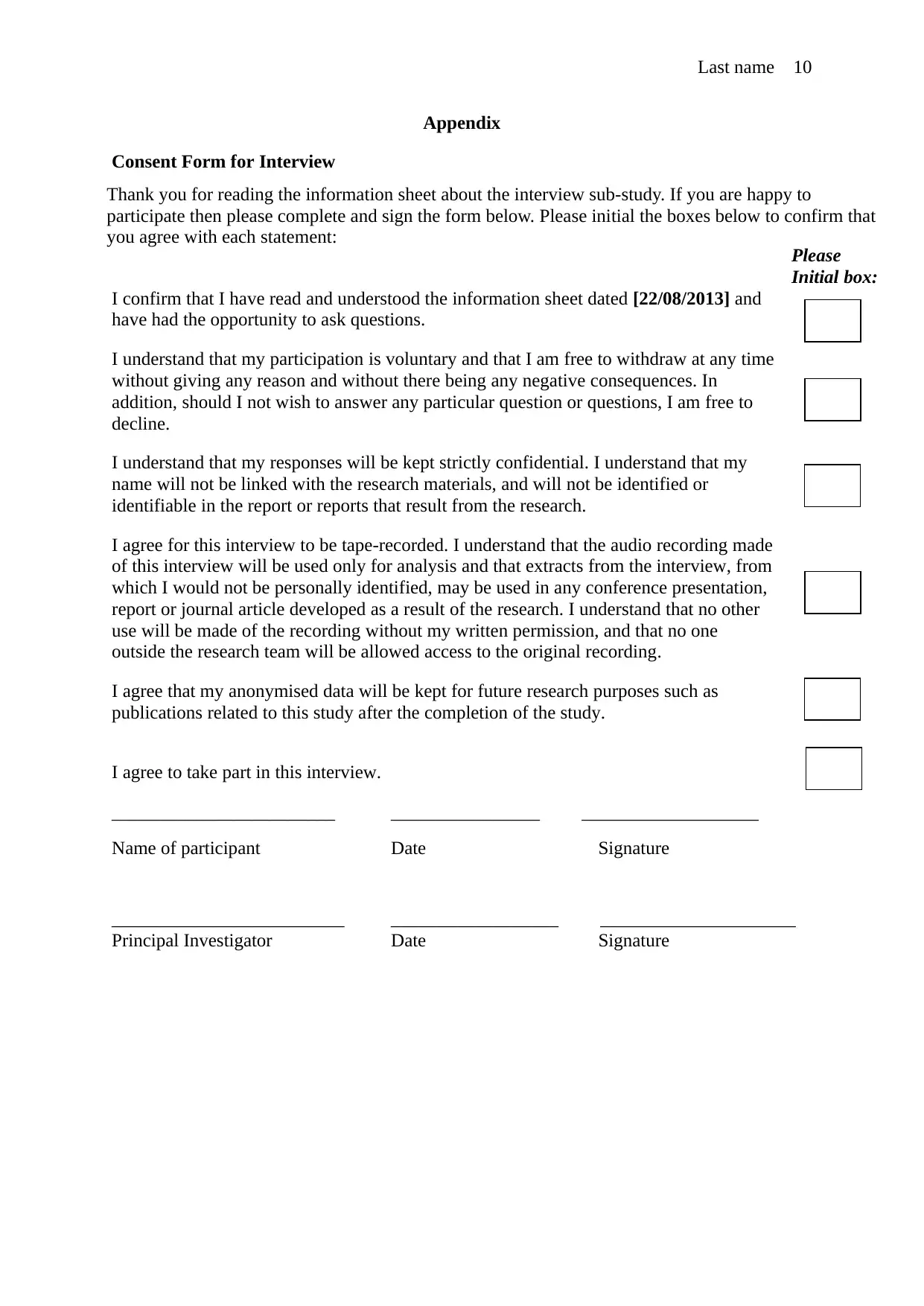
Last name 10
Appendix
Consent Form for Interview
Please
Initial box:
I confirm that I have read and understood the information sheet dated [22/08/2013] and
have had the opportunity to ask questions.
I understand that my participation is voluntary and that I am free to withdraw at any time
without giving any reason and without there being any negative consequences. In
addition, should I not wish to answer any particular question or questions, I am free to
decline.
I understand that my responses will be kept strictly confidential. I understand that my
name will not be linked with the research materials, and will not be identified or
identifiable in the report or reports that result from the research.
I agree for this interview to be tape-recorded. I understand that the audio recording made
of this interview will be used only for analysis and that extracts from the interview, from
which I would not be personally identified, may be used in any conference presentation,
report or journal article developed as a result of the research. I understand that no other
use will be made of the recording without my written permission, and that no one
outside the research team will be allowed access to the original recording.
I agree that my anonymised data will be kept for future research purposes such as
publications related to this study after the completion of the study.
I agree to take part in this interview.
________________________ ________________ ___________________
Name of participant Date Signature
_________________________ __________________ _____________________
Principal Investigator Date Signature
Thank you for reading the information sheet about the interview sub-study. If you are happy to
participate then please complete and sign the form below. Please initial the boxes below to confirm that
you agree with each statement:
Appendix
Consent Form for Interview
Please
Initial box:
I confirm that I have read and understood the information sheet dated [22/08/2013] and
have had the opportunity to ask questions.
I understand that my participation is voluntary and that I am free to withdraw at any time
without giving any reason and without there being any negative consequences. In
addition, should I not wish to answer any particular question or questions, I am free to
decline.
I understand that my responses will be kept strictly confidential. I understand that my
name will not be linked with the research materials, and will not be identified or
identifiable in the report or reports that result from the research.
I agree for this interview to be tape-recorded. I understand that the audio recording made
of this interview will be used only for analysis and that extracts from the interview, from
which I would not be personally identified, may be used in any conference presentation,
report or journal article developed as a result of the research. I understand that no other
use will be made of the recording without my written permission, and that no one
outside the research team will be allowed access to the original recording.
I agree that my anonymised data will be kept for future research purposes such as
publications related to this study after the completion of the study.
I agree to take part in this interview.
________________________ ________________ ___________________
Name of participant Date Signature
_________________________ __________________ _____________________
Principal Investigator Date Signature
Thank you for reading the information sheet about the interview sub-study. If you are happy to
participate then please complete and sign the form below. Please initial the boxes below to confirm that
you agree with each statement:
1 out of 10
Related Documents
Your All-in-One AI-Powered Toolkit for Academic Success.
+13062052269
info@desklib.com
Available 24*7 on WhatsApp / Email
![[object Object]](/_next/static/media/star-bottom.7253800d.svg)
Unlock your academic potential
© 2024 | Zucol Services PVT LTD | All rights reserved.




